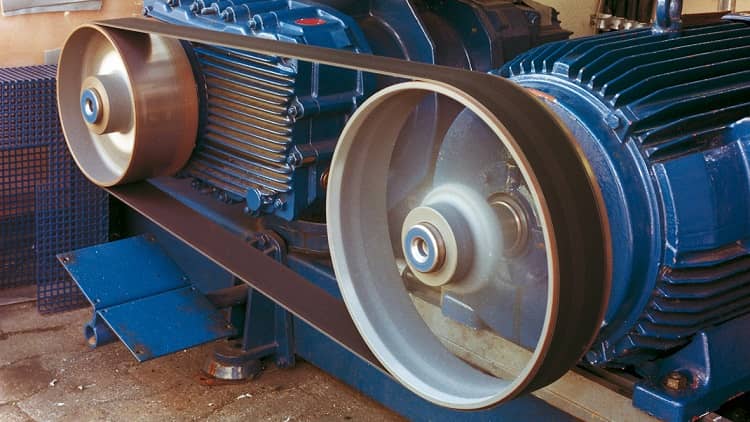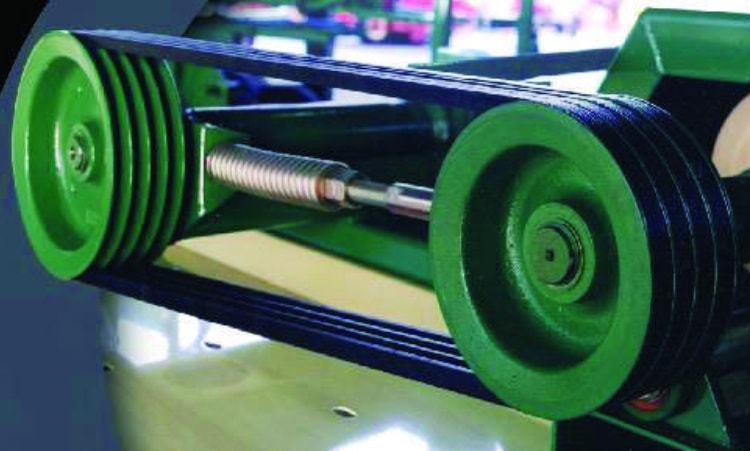Machine can be defined as the cluster of mechanisms that can perform certain task by expanding energy. Majority of the machines are driven be mechanical power, which is nothing but torque of rotational shaft. A prime mover is used to convert other form of energy to mechanical energy. For example, an electric motor converts electric energy into mechanical power. However, such prime movers are located away from the machine unit and thus another transmission system is desired. Here comes the role of mechanical power transmission system, which transmits motion, torque and power from driver element (like prime mover) to the driven element (such as machine unit). Four mechanical drives, namely gear drive, belt drive, chain drive and rope drive are utilized to serve this purpose.
Belt drive is one friction drive where motion and power are transmitted by means of friction. Here two pulleys are first mounted with the driver and driven shafts. An endless belt is then partially wrapped around the pulleys maintaining appropriate tension. Belt drive is suitable for small to long distance power transmission and can inherently protect the system from overloading and vibration. Since friction force between the pulley and the belt helps transmitting power, capacity of belt drive is mainly limited by frictional characteristics, contact angle and initial tension. One way to increase transmission capacity is by increasing wrap or contact angle. This can be done by replacing open belt drive by cross belt drive, if otherwise permitted.

Another way of improving power transmission capacity is by increasing contact area between the belt and pulley. This is realized by employing V-belt drive. In flat belt drive a joined belt of rectangular cross-section is used where only one flat face of the belt remains in contact with the pulley. Although its capacity is low, it is overwhelmingly used for long distance power transmission. It can have two arrangements—open and crossed. V-belt drive utilizes an endless trapezoidal (cross-section) belt with pulleys having corresponding V-grove. Here two side surfaces of the belt remain in contact with pulley, which increases transmission capability and reduces slip. However, it is particularly suitable when driver and driven shafts are small distance away. Various differences between flat belt drive and V-belt drive are given below in table format.
Table: Difference between flat belt drive and V-belt drive
| Flat Belt Drive | V-Belt Drive |
|---|---|
| Flat belt has rectangular cross-section where width is substantially larger than thickness. | V-belt has trapezoidal cross-section where larger side width is almost same with thickness. |
| Flat belt is jointed (hinged). So it produces vibration and noise. | V-belt is made endless. Thus its operation is smooth and quite. |
| In flat belt drive, only one surface of the belt remains in contact with the pulleys. | In V-belt drive, two side surfaces of the belt remain in contact with the pulleys. |
| Power transmission capacity of flat belt is comparatively lower due to higher chance of slip. | V-belt can transmit more power without slip due to increased friction. |
| It is recommended for long distance power and motion transmission. | It is preferred for short to medium distance power and motion transmission. |
| Slip also limits the achievable speed reduction. Up to 1:4 reduction is attainable. | Higher speed reduction, up to 1:7, is attainable. |
| In case of stepped pulley system, flat belt can be shifted from one diameter pulley to another without pausing the rotation. | V-belt cannot be utilized for stepped pulley system as shifting from one pulley to another is infeasible. |
| Flat belt and corresponding pulleys are simple in construction. So this arrangement is cheaper. | V-belt and corresponding pulleys have complicated construction. So it is costlier. |
Configuration of belt: A flat belt is hinged at one point to make an endless belt. It has rectangular cross-section where the width is substantially larger than the thickness. Only inside surface of the belt can come in contact with the pulleys. The pulleys have cylindrical shape where the outer surface only touches the belt. Therefore the friction force between the outer surface of the pulley and inner surface of the belt is utilized to transmit motion and power from driver shaft to driven shaft. On the other hand, a V-belt has trapezoidal cross-section where width of the belt in larger side is almost same with the thickness. The pulley also has a V-groove to accommodate the belt. V-angle of the pulley should match with the angle between two non-parallel faces of the belt.
Noise and vibration: As mentioned earlier, a flat belt is hinged using nuts and bolts to make it endless. A groove always exists at this junction. Due to the unsymmetrical inside surface of the belt, flat belt drive produces considerable noise and vibration. This sometimes limits its application at very high speed. On the other hand, the V-belt is produced in endless fashion and thus no joining exist. Thus it produces less vibration and its operation is also quite.

Contact between belt and pulley: As mentioned earlier, only inside surface of the flat belt remains in contact with the outer surface of the cylindrical pulley. In case of V-belt, two inclined surfaces simultaneously remain in contact with the two side surfaces of the V-shaped pulley.
Power transmission capacity: Like every mechanical drive, basic purpose of belt drive is to transmit motion and power from one shaft to another. Since belt drive is one friction drive, so power transmission capacity primarily relies on the frictional characteristics of the mating surfaces. Whenever load exceeds frictional force, slip occurs automatically. Higher the coefficient of friction between the belt and pulley, higher will be the transmission capacity; however, heat generation and wear will also be more. Instead of directly increasing the coefficient of friction, it can be enhanced indirectly by employing V-belt instead of flat belt. It can be proved that effective coefficient of friction in V-belt is 2 – 3 times higher (based on V-angle of the belt, which is usually 40°) compared to flat belt of same material. Accordingly, V-belt drive can transmit substantially higher power without slip.
Distance between shafts: A suitable mechanical drive is selected based on the centre distance between driver and driven shafts. For example, gear drive is suitable for small centre distance, typically up to 1m. Chain drive can be employed for small to moderate distance, usually up to 3m with the assistance of idle sprockets. Belt drive can be utilized for a wide range of centre distances—from below 1m to as long as 15m. A flat belt drive is particularly suitable for long distance power transmission; whereas, V-belt is preferred for small distance only (usually below 1m).
Speed reduction: Machine units are driven by prime movers. Usually the driver shaft of the prime mover rotates at higher speed than it is required in driven shaft of the machines. Thus a reduction in rotational speed is required and this can be achieved by changing the diameters of the driver and driven pulleys. However, every mechanical drive can alter velocity ratio within a range. A flat belt drive can offer speed reduction up to 1:4; higher than this can undesirably increase slip. Because of higher effective coefficient of friction, V-belt offers higher speed reduction, even up to 1:7.
Shifting of belt: Sometimes a single machine unit requires varying speed at different stages of operation. Also, a single prime mover can be employed for driving multiple machines, each requiring varying speed of operation. In such scenario, stepped pulley is adopted where a number of pulleys having different diameter is mounted on a single shaft. If flat belt is employed then the belt can be shifted easily from one pulley to another in running condition. Thus rotational speed of the driven shaft can be altered without stopping the driver unit (a mechanised adjustment of belt length is highly required to maintain belt tension). Such shifting provision is not available in V-belt drive as they require specialized pulley with V-groove.
Economic aspect: Constriction of flat belt and corresponding pulley is simple. Length of the flat can also be adjusted multiple times as it is jointed by nuts and bolts. Longevity and easy construction make this drive unit cheaper. V-belt and corresponding pulley is costlier. Its length cannot be adjusted and thus it has shorter service life.
Scientific comparison among flat belt drive and V-belt drive is presented in this article. The author also suggests you to go through the following references for better understanding of the topic.
- Design of Machine Elements by V. B. Bhandari (Fourth edition; McGraw Hill Education).
- A Textbook of Machine Design by R. S. Khurmi and J. K. Gupta (S. Chand; 2014).

